Bpag
BPAG COMDTPUB P16591.3C Final CG-612 Submission.docx
Bridge Permit Application Guide (BPAG)
BPAG
OMB: 1625-0015
OFFICE
OF BRIDGE PROGRAMS, U.S. COAST GUARD Bridge
Permit Application 
Guide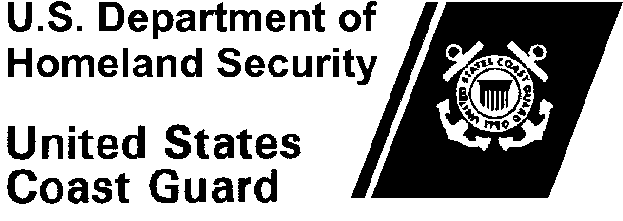

COMDTPUB
P16591.3C OCTOBER
2011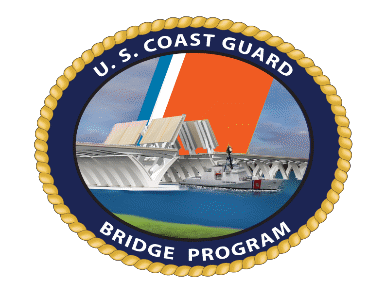
Promulgation Letter
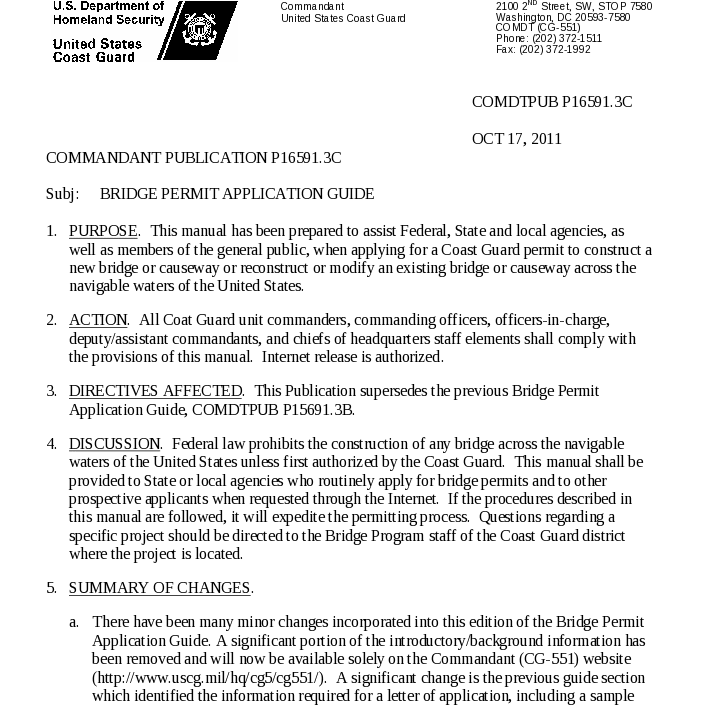
COMDTpub p16591.3c

TABLE OF CONTENTS
Section 1 INTRODUCTION TO THE PERMITTING PROCESS 1
Section 2 PERMIT APPLICATION 3
1. Where to submit the permit application 3
b. Consultant/Agent information 3
d. Legal Authority for proposed action 4
e. International bridges (if applicable) 4
f. Dimensions of the navigation opening 4
g. Waterway characteristics, usage and prospective impacts 5
i. Removal of existing bridge(s) 7
j. Other Agencies with jurisdiction 7
k. Summary of environmental analysis 7
3. Attachments to the application package 7
a. Map of the location/vicinity and plan sheets 7
b. Environmental Evaluation or Re-Evaluation 7
e. Lead federal agency’s CE, EA or EIS 7
f. Authorization to make application 8
g. Consultant/ Agent authorization letter 8
j. Extracts of motions from meetings 8
k. Water quality certification 8
m. State agency concurrence in CZM 8
o. Summary of preliminary conferences and early coordination 8
4. Applications for Extensions of Time 8
a. Letter requesting extension of time 8
1) Description of construction 8
2) Status of the construction work 8
3) Why an extension is needed 8
4) Percentage of project completed 8
b. Water Quality Certification 9
d. State concurrence with CZM 9
e. Environmental documentation 9
g. Details of the Bridge Protective System 12
h. Temporary Structures/Falsework 12
EXAMPLE 2.1 - Example of Permit Plans, Location and Vicinity Maps 13
EXAMPLE 2.2 - Example of Permit Plans, Combined Vicinity and Location Map 14
EXAMPLE 2.3 - Example of Permit Plans, Combined Plan and Elevation Views 15
EXAMPLE 2.4 - Example of Permit Plans, Combined Plan and Elevation Views 16
EXAMPLE 2.5 - Example of Permit Plans, Combined Plan and Elevation Views 17
EXAMPLE 2.6 - Example of Permit Plans, Plan View 18
EXAMPLE 2.7 - Example of Permit Plans, Elevation View 19
EXAMPLE 2.8 - Example of Permit Plans, Typical Cross Section 20
EXAMPLE 2.9 - Example of Permit Plans, Bridge Protective System 21
EXAMPLE 2.10 - Example of Permit Plans, Bridge Protective System 22
C. ENVIRONMENTAL DOCUMENTATION REQUIREMENTS 23
1. Required information for application package 23
c. Coastal Zone Management Plan 24
e. Historic/cultural resources 25
1) Threatened and endangered species 26
k. Residential or business displacement 30
l. Prime and unique farmland 30
m. Other environmental control laws 30
The Coast Guard approves the location and plans of bridges and causeways and imposes any necessary conditions relating to the construction, maintenance, and operation of these bridges in the interest of public navigation. A bridge permit is the written approval of the location and plans of the bridge or causeway to be constructed or modified across a navigable waterway of the United States. Any individual, partnership, corporation, or local, state, or federal legislative body, agency, or authority planning to construct or modify a bridge or causeway across a navigable waterway of the U.S. must apply for a Coast Guard bridge permit in accordance with 33 CFR 115.50.
Additional information regarding Coast Guard permitting can be found online at http://www.uscg.mil/hq/cg5/cg551/default.asp Federal law prohibits the construction of these structures unless the Coast Guard first authorizes them. By following the procedures in this publication the Coast Guard can efficiently process a bridge permit application.
This guidance is not a substitute for applicable legal requirements, nor is it itself a rule. It is not intended to nor does it impose legally-binding requirements on any party. It represents the Coast Guard’s current thinking on this topic and may assist industry, mariners, the general public, and the Coast Guard, as well as other federal and state regulators, in applying statutory and regulatory requirements. You can use an alternative approach for complying with these requirements if the approach satisfies the requirements of the applicable statutes and regulations. If you want to discuss an alternative approach (you are not required to do so), you may contact the District Commander who is responsible for implementing this guidance.
The Coast Guard bridge permitting process is directed by laws, policies, professional standards, and other requirements. This chapter is a guide to help you through the bridge permit application process. Additional information may be found at 33 CFR, Parts 114 and 115.
Salutation (i.e. Dear Sir;)
Application is hereby made for a Coast Guard Bridge Permit.
Applicant information:
Consultant/Agent information (if employed):
Proposed Bridge(s):
Lead federal agency for environmental review;
Name of the waterway that the bridge crosses;
Number of miles above the mouth of the waterway where the bridge is located and provide latitude and longitude at centerline of navigation channel (contact the local Coast Guard Bridge Office for guidance);
City or town, county, and state where the bridge is located at, near, or between;
Brief description of project to include type of bridge proposed and existing bridge at project site, if applicable;
Purpose and need of project;
Estimated cost of bridge and approaches;
Type and source of project funding (federal, state, private etc).
Legal Authority for proposed action:
The primary authority for the construction of the bridge and under what legislative authority the bridge is being built (state permit, charter, or statement of ownership of lands); typically the General Bridge Act of 1946, as amended; and
The legislative authority for the existing bridge as listed in the original permit if it is to be replaced.
If the applicant does not own the existing bridge which is being replaced or modified, include a signed statement from the bridge owner authorizing the removal or modification work.
International bridges (if applicable):
The International Bridge Act of 1972, or a copy of the Special Act of Congress if constructed prior to 1972, should be cited as the legislative authority for international bridge construction; and
Presidential approval shall be obtained from the State Department prior to issuing a Coast Guard bridge permit under the International Bridge Act of 1972.
NOTE: Please include a copy of State Department approval for international bridges in the application package for a Coast Guard bridge permit.
Dimensions of the navigation opening: (All navigational clearances should be stated in US linear feet. Provide clearances in meters if international bridge).
Vertical clearance: This is the vertical distance between the lowest part (e.g., member, chord, or steel) of the superstructure spanning the navigation channel and the recognized datum (e.g., MHW, 2% flow line, etc.) at the bridge site. Cite clearances above the appropriate high water elevation and low water elevation. In the case of movable bridges, cite clearances in the open and closed positions. In some situations, vertical clearances should be cited at the margins of channel, and for a bascule bridge clearances at the tip of the leaves, if not fully open.
Horizontal clearance: This is the horizontal distance, measured normal to the axis of the channel, through which the stated vertical clearance is available. Clearance may be between piers (full width of the span), between the bridge protective system, or bank-to-bank in the case of a bridge having no piers in the waterway.
Length of bridge project: This is the horizontal distance from abutment-to-abutment or approach-to-approach.
Width of project: This is the width of the bridge at its widest point (out-to-out).
Depth of the waterway: At the appropriate elevation (e.g., NGVD 1929, NAVD 1988, etc.).
Width of waterway: At project site at MHW if tidal or OHW if non-tidal.
We recommend you discuss waterway characteristics, waterway usage, and prospective long term navigational impacts of the proposed project, and include:
The name and contact information for marine facilities within a 3-mile radius of the project [public boat ramps, marinas (or major docking facilities), boat repair facilities, etc.];
The approximate width of the waterway at the proposed bridge location (bank to bank, shoreline to shoreline, etc.);
The depths of the waterway at the proposed bridge location in and around the navigation channel;
A description of vessels on the waterway that are engaged in emergency operations, national defense activities, or channel maintenance, and any potential impacts to their operation;
Information regarding whether the Corps of Engineers has completed or plans to complete a federal navigation project on this waterway;
A description of the present and prospective recreational navigation on the waterway, indicating whether the proposed project will have an impact on the safe, efficient movement of any segment of the present or prospective recreational fleet operating on the waterway;
A description of the present and prospective commercial navigation and the cargoes moved on the waterway, indicating whether the proposed project will have an impact on the safe, efficient movement of any segment of the present or prospective commercial fleet operating on the waterway;
Whether the proposed bridge will block access of any vessel presently using local service facilities;
Whether alternate routes bypassing the proposed bridge are available for use by vessels unable to pass the proposed bridge;
A description of any local harbor, indicating whether the bridge will prohibit the entry of any vessels to the local harbor refuge;
Whether the proposed bridge will be located within one-half mile of a bend in the waterway;
Whether there are factors located within one-half mile of the proposed bridge which would create hazardous passage through the proposed structure and a description of each factor;
Whether local hydraulic conditions increase the hazard of passage through the proposed bridge and a description of these conditions;
Whether atmospheric conditions increase the hazard of passage through the proposed bridge and a description of these conditions;
A description of guide clearances established for the waterway, if applicable. If not, indicate whether clearance gauges are needed and why;
A description of any other factors considered necessary for the safe, efficient passage of vessels through the proposed bridge; and
A description of the impacts to navigation caused or which could be reasonably caused by the proposed bridge including but not limited to: proposed construction methodology, proposed or prospective changes to the existing bridge operating schedule (for movable bridges), and any proposed mitigation to all unavoidable impacts to navigation.
Conduct a navigational evaluation, and include a review of all bridges upstream and downstream of the proposed site to determine the minimum vertical and horizontal clearances available on the waterway.
If the proposed bridge is fixed, and is replacing an existing drawbridge with unlimited vertical clearance, you must determine whether the proposed bridge will accommodate existing and perspective navigation.
Existing bridge(s) if applicable:
Name(s) of bridge: e.g., US 40 Highway Bridge; or Coleman Memorial Bridge; or State Route 7 Bridge also known as Preston Falls Bridge;
Type of bridge: e.g., fixed or moveable (drawbridge, bascule, vertical lift, swing span); highway, railway, pedestrian, pipeline;
Mile point, latitude and longitude at centerline of bridge, and navigational clearances, in linear measurement; and
Owner of the bridge.
Discuss construction methodology and removal of existing bridge(s), as applicable:
NOTE: Because the safety of navigation is of paramount importance, the Coast Guard shall make the final decision concerning the extent of bridge removal.
Other Agencies with jurisdiction over the proposed project:
Summary of environmental analysis.
Signature Block (applicant/consultant/agent).
Include the following attachments (if applicable) with the application package:
Original and one copy of map of the location/vicinity and plan sheets on standard 8 ½ x 11” paper (See Plan Sheet Checklist);
Environmental Evaluation or Re-Evaluation (contact the local Coast Guard District Office for re-evaluation requirements). (See Section 2.C.);
Navigation Survey to support vertical and horizontal navigation clearance requirements;
Vessel Impact Assessment, if required by the District Commander;
Lead federal agency’s Final CE determination, EA, EIS, FONSI, or ROD as appropriate (If EIS, provide EPA filing dates for DEIS & FEIS). When the Coast Guard is the lead federal agency, the Coast Guard must concur with the selection of the consultant used for the development of the environmental document;
Authorization for applicant to make application to modify or remove another’s bridge;
Consultant/ Agent authorization letter;
Proof of ownership of existing bridge;
Proof of right to build (ownership of land);
Extracts of motions from meetings authorizing construction of the proposed bridge;
Water quality certification under 33 U.S.C. 1251 (and proof of application requesting it), to include time extensions, waivers, or a statement from the certifying agency that the WQC is either still valid or that WQC is not needed. (See Section 2.C.1.b.);
CZM consistency statement, to include time extensions. (See Section 2.C.1.c.);
State agency concurrence in CZM consistency certification, to include time extensions, or a statement from the certifying agency that the state concurrence is still valid;
List of property owners – at a minimum adjacent property owners, formatted in Microsoft Excel, or comparable spreadsheet software. Please contact the local bridge office for additional guidance; and
Provide a summary of preliminary conferences and early coordination or scoping efforts with applicant and/or interested parties. Include information about public meetings.
Applications for Extensions of Time.
Per 33 CFR 114.45, applicants must submit to the appropriate Coast Guard District Commander, time extension requests to commence or complete bridge construction, or to remove a bridge being replaced as part of a permitted bridge project. Submit the following information when requesting an extension of time:
Description of construction;
Status of the construction work;
An explanation of why the project will not be commenced/completed on time, i.e. why an extension is needed;
Percentage of project completed to date;
Projected completion date and how long the applicant wishes for the permit extension;
Water Quality Certification and application for Certification;
Coastal Zone Management (CZM) consistency certification;
State concurrence with CZM consistency certification; and
Environmental documentation: Any categorical exclusions, environmental assessments, environmental impact statements, supplemental studies, findings of no significant impact, records of decision or reevaluations required by the lead agency.
PLAN SHEETS - Plans submitted with the bridge permit application become an official, and permanent, part of the issued permit or permit. To minimize delays, provide the following information:
____ Provide all plans on standard 8 ½ X 11” paper. Include the original plus one copy of the plans (of good reproducible quality), on the fewest sheets possible that still show significant project structural details.
NOTE: Do not show bridge navigational lighting plans on bridge plan and elevation views. Use a separate sheet for the bridge lighting plan.
____ Show all dimensions and distances in U. S. linear feet. For international bridges also show all dimensions in metric equivalent.
____ Include the datum used in the plan and elevation view. Use the same datum for all submitted drawings (e.g. NAVD, NGVD).
____ All plan sheets shall bear the stamp of a professional engineer certifying the design meets American Association of State Highway and Transportation Officials (AASHTO) and/or American Railway Engineering and Maintenance-of-Way Association (AREMA) standards, including private bridges. If the bridge has been designed to withstand vessel impact, a certified statement to that effect, along with the design vessel chosen, shall be included on the plan sheets by a professional engineer.
____ Applicant/Owner;
____ Consultant/Agent;
____ Name of Bridge;
____ Name of Waterway;
____ Mile point of bridge location (from confluence of mouth of waterway) in statue miles;
____ City, County, and State (state at, near, or between – as appropriate);
____ Date of plans (i.e. mm/dd/yyyy); and
____ Sheet number of total number of sheets in set (i.e. Sheet 1 of 5).
____ Show graphic scale and north arrow;
____ Show location of bridge on waterway;
____ Identify the name of the waterway;
____ Show course of waterway (i.e. ebb/flood);
____ Show structures immediately adjacent to the proposed bridge and their relation to the proposed bridge;
____ Identify wildlife and waterfowl refuges and any historical and archaeological sites; and
____ Insert a small map of the state in which the project is located with an arrow showing the location of the proposed project.
____ Show graphic bar scale and north arrow;
____ Identify the adjacent property owners at the four corners of the proposed structure(s);
____ Show existing shorelines;
____ Show ebb and flood in tidal waters and direction of flow in non-tidal waterway;
____ Show mean high and low waterlines in tidal areas. Show ordinary high water and ordinary low water elevations if proposed activity is in a non-tidal waterway;
____ Show all portions of existing bridge(s) that will remain in place;
____ Show principal dimensions of structure(s) from grade to grade. Show length, width, etc.;
____ Show location of dredging, excavation, fill or rip-rap. Give approximate number of cubic yards;
____ Show location of the bridge protective system, piles, cables, etc. existing or to be constructed in the waterway. Identify type of material to be utilized;
____ Show limits of navigational channel;
____ Show axis of channel;
____ Show horizontal clearances, normal to the axis of the channel between the bridge protective system, pilings, or abutments;
____ Show water depth at mean low (or ordinary low if non-tidal) at various locations in the channel, under, upstream and downstream of the bridge; and
____ Show outline of the bridge protective system.
____ Show graphic bar scale and north arrow;
____ Show mean high and mean low water elevations in tidal areas. Show ordinary high and low water elevations in non-tidal areas;
____ Show amount of fill in cubic yards below mean high water;
____ Show horizontal clearance normal to the axis of the channel between the bridge protective system, pilings, or abutments, as appropriate for navigational channel;
____ Show vertical clearances referenced to the appropriate high water stage either Mean High Water (MHW) or Ordinary High Water (OHW). Show vertical clearances at the center, as well as at the horizontal limits of the navigational channel (the most restrictive vertical clearance in the navigational channel);
____ If the bridge will have a draw, show the draw in the open and closed positions;
____ Show proposed and existing contour of waterway bottom; and
____ Show 100-year flood elevation.
____ Show graphic bar scale;
____ Show out-to-out width of the structure(s). (This is the width of the bridge at its widest point.); and
____ Include location and dimensions of travel lanes, shoulders, sidewalks, fishing/pedestrian platforms, railings, pipelines, etc.
PLEASE SUBMIT THE FOLLOWING PERMIT PLAN SHEETS SEPARATELY IF APPLICABLE:
____ Show bridge protective system in plan and elevation views including detail of attachment to pier, countersunk bolts, and relationship to mean high and low waterlines (on elevation view).
____ Show temporary structures/falsework;
____ Show existing bridge(s) to be removed; and
____ Show minimum horizontal and vertical clearances during construction.
____ Submit lighting plan application in accordance with 33 CFR 118 and bridge lighting guide (see USCG Bridge Program website). This is a separate application from the bridge permit application.
Location and Vicinity Maps

Combined
Vicinity and Location Map
Combined
Plan and Elevation Views
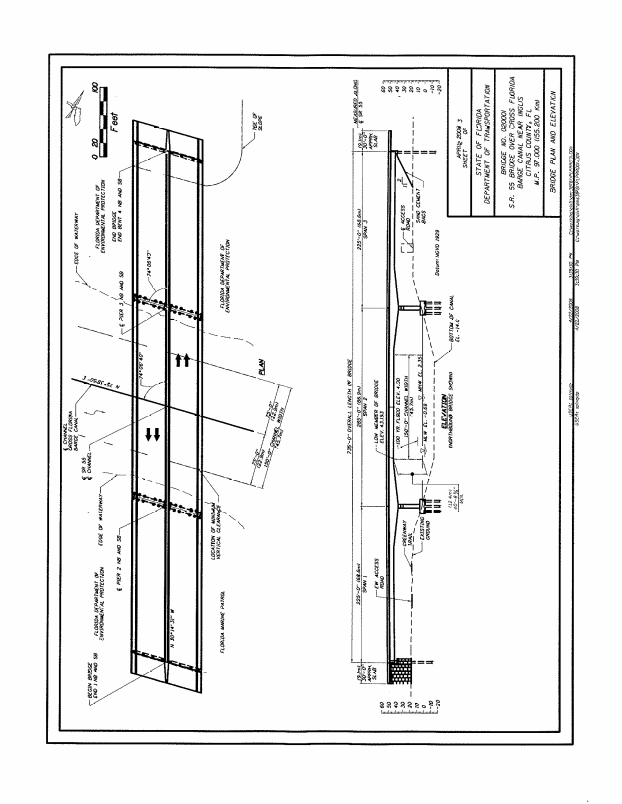
Combined Plan and Elevation Views
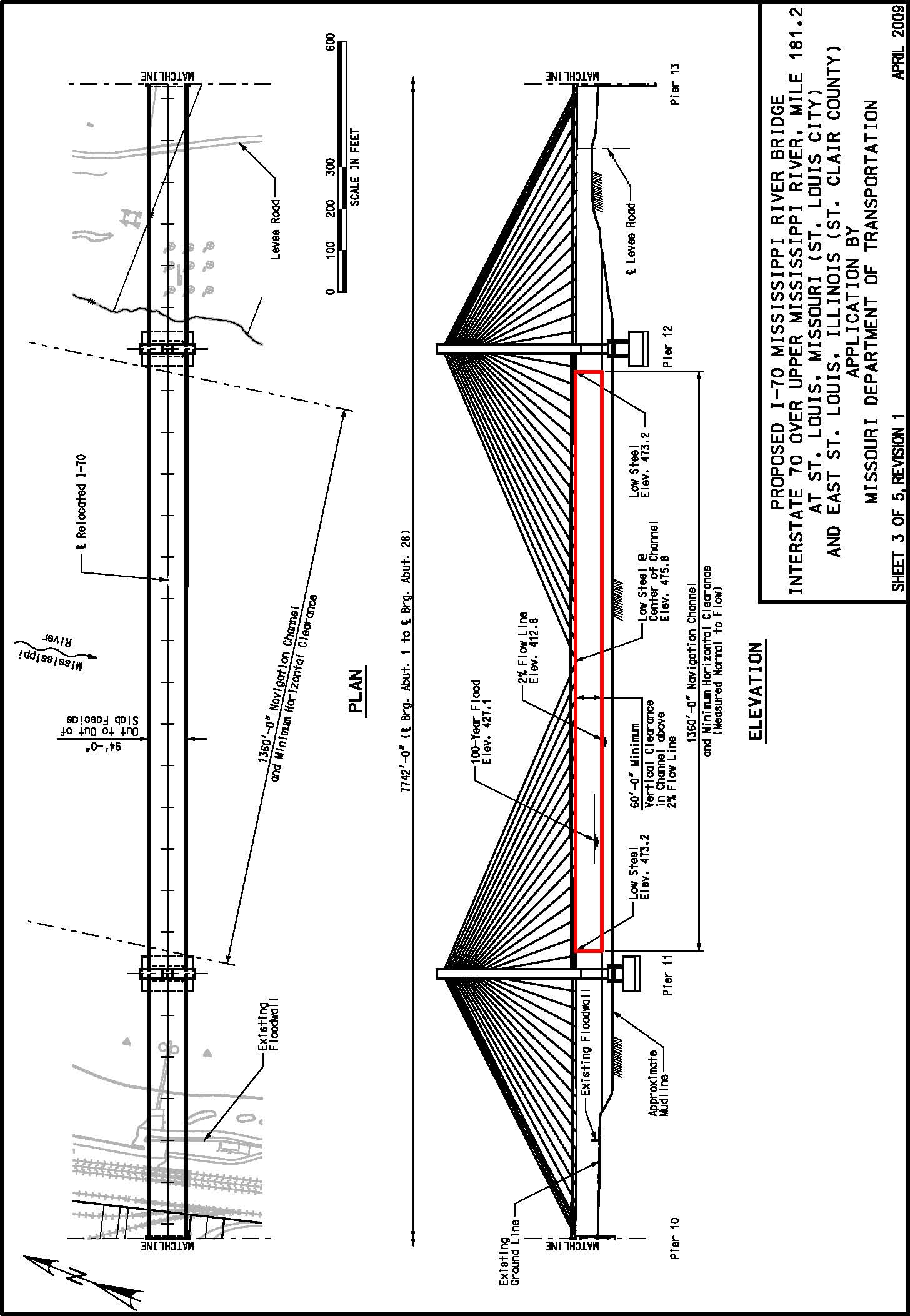
Combined Plan and Elevation
Views
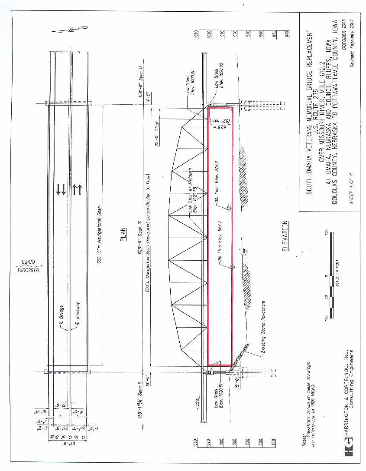
Plan View
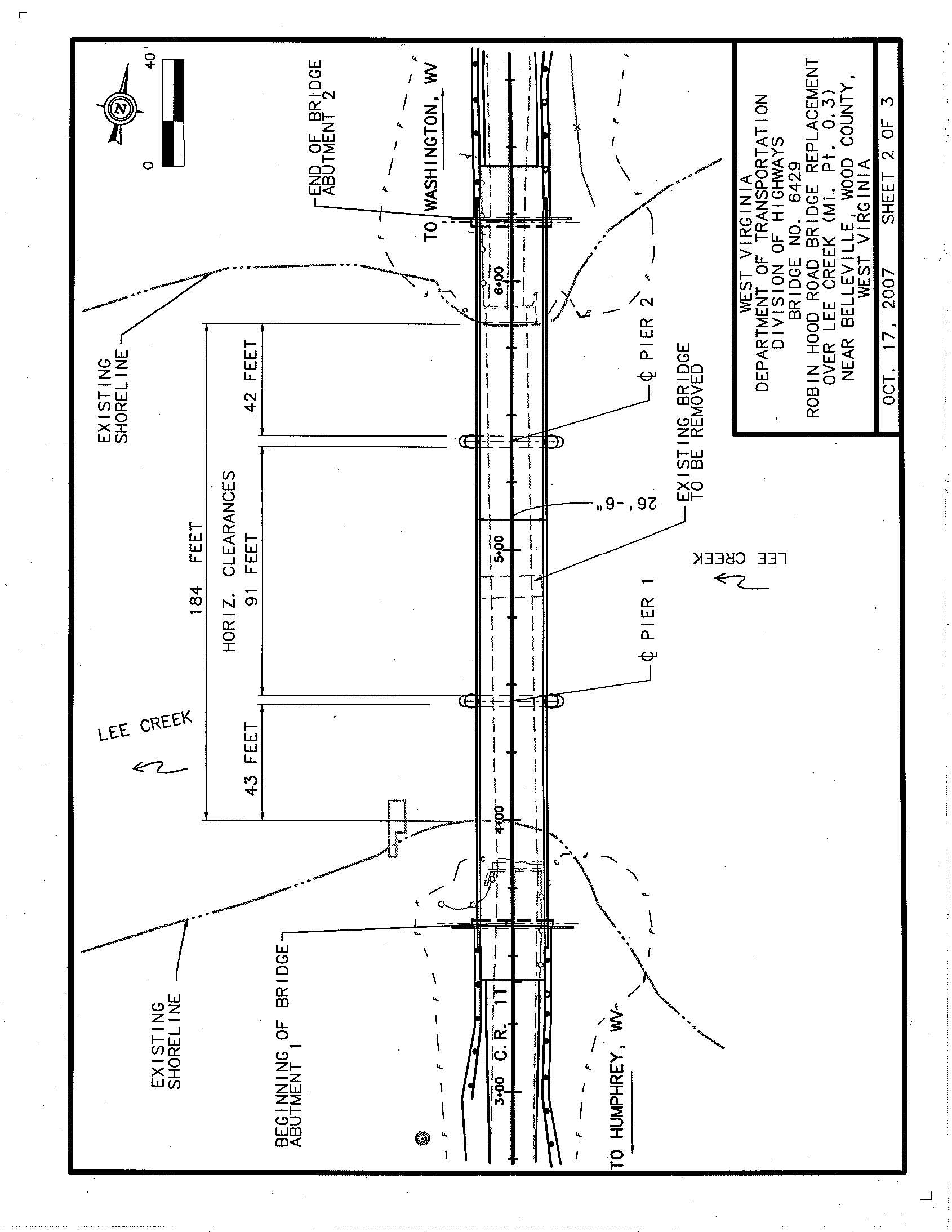
E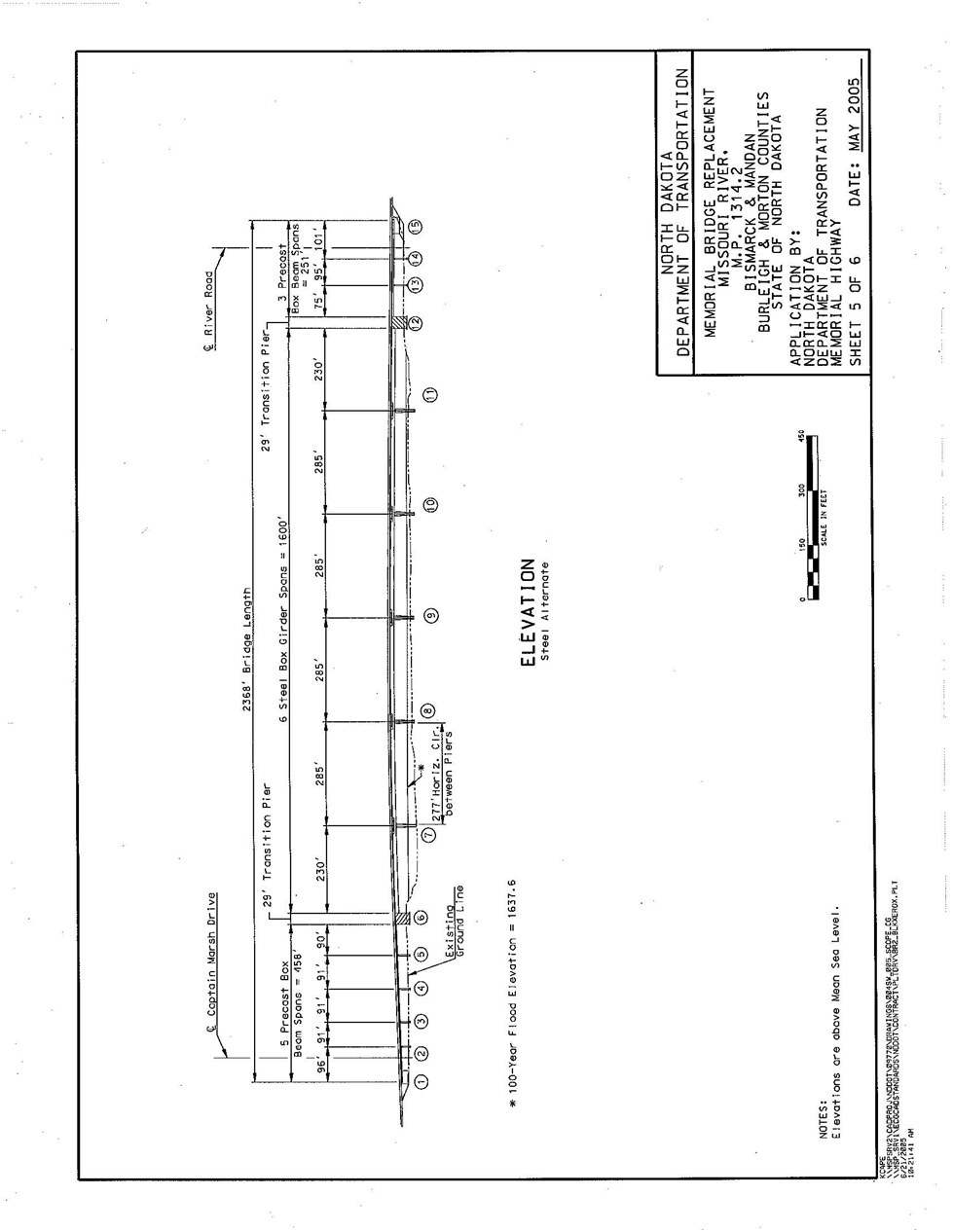 levation
View
levation
View
Typical Cross Section

Bridge Protective System
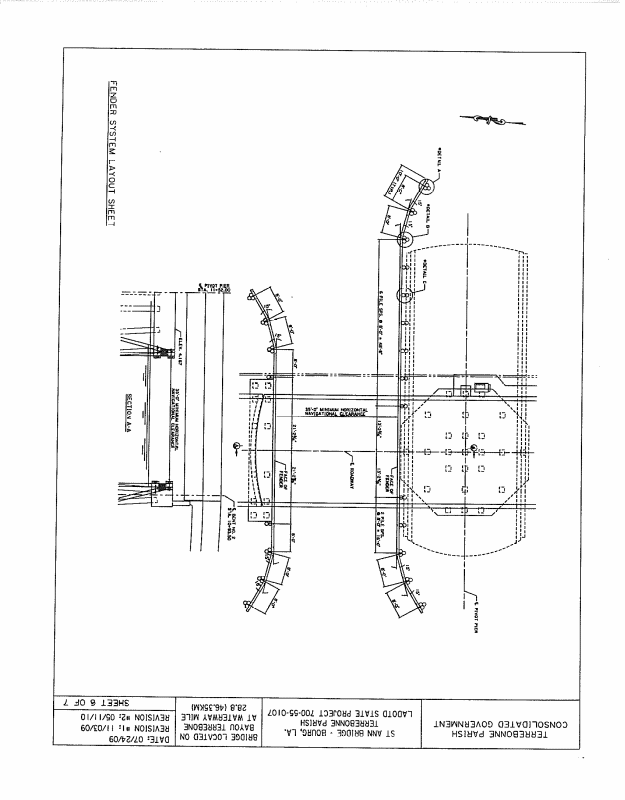
Bridge Protective System

ENVIRONMENTAL DOCUMENTATION REQUIREMENTS
Per the National Environmental Policy Act (NEPA) of 1969 (42 U.S.C. 4321) as amended, and its implementing regulations (40 CFR 1500-1508), the following information is required for all application packages:
Alternatives: NEPA requires all federal agencies to use a systematic, interdisciplinary, scientific approach when analyzing project impacts under their respective jurisdictions.
These studies must assess: primary and causally related impacts due to the construction of the proposed bridge project, irreversible or irretrievable commitments of resources, comments of federal, state and local government agencies having jurisdiction by law or expertise, and comments of other interested parties or groups. The potential impacts on navigation are considered to be a significant part of the environmental impacts and shall be included in the NEPA review process. When the Coast Guard is the lead federal agency in a project involving a bridge, the NEPA jurisdiction extends to the logical termini on both sides of the bridge or the bridge and road sections having independent utility.
Per 40 CFR 1502.14, the following information is required to document alternatives:
Identification of the alternatives for the proposed project (Alternatives provided should be more than just build and no build. Alternatives should include various bridge types considered.);
Location;
Design;
Probable impacts of each alternative on the quality of the human environment;
Commitments of resources; and
Comments of federal, state and local government agencies, and other interested parties or groups. (For further information, contact the local Coast Guard District.)
Clean Water Act Coordination: Section 401 of the Clean Water Act of 1977 (33 U.S.C. 1251), as amended, prohibits federal permitting or licensing agencies from issuing authorizations for construction activities having discharges into navigable waters, until the appropriate water quality certifying agency has issued a water quality certification or waiver procedures have been satisfied.
Water Quality Certification: If applicable to the proposed project;
State certifying agency name and point of contact with phone and email address. (e.g., State DEP, Water Management District, State Department of Natural Resources, etc.);
Obtain a Water Quality Certification (WQC), waiver or statement that the WQC is not required from the appropriate federal, interstate, or state agency and include in the permit application package, along with a copy of the WQC application, if applicable;
If the WQC has not yet been obtained, but has been applied for, include the proof of application in the permit application package;
If WQC was waived, provide authority of the waiver; and
Specify if the WQC is granted under a Programmatic Agreement (e.g., US Army Corps of Engineers Nationwide Permit (NWP) and the NWP number, etc.).
NPDES Permit: List coordination, date(s), enclosures, and EPA comments, if applicable.
Safe Drinking Water Act: List coordination, date(s), enclosure(s), and EPA comments, if applicable.
Coastal Zone Management Plan: The Coastal Zone Management (CZM) Act of 1972 (16 U.S.C. 1451), as amended, and its implementing regulations (15 CFR 930), requires all projects located within the designated coastal zone of a state to be consistent with the state's federally approved CZM plan.
Section 307 of that act instructs federal agencies not to take action until they have received written certification from the applicant and the state CZM agency, signifying that the proposed project is consistent with the state's coastal zone management plan.
If the State or territory has a federally approved CZM plan, and the project is located in the coastal zone, the following information is required:
Per the Coastal Barrier Resources Act of 1982: 16 U.S.C. 3501, verify that the proposed project complies with the listed act’s guidance (if applicable).
List Executive Order 13089 – Coral Reef Protection coordination, and US Coral Reef Task Force, if applicable.
Floodplain: The base floodplain is the area that would be inundated by a base flood or 100-year flood. The base flood is defined as that flood having a one-percent chance of being exceeded in any given year. Executive Order 11988, Floodplain Management and Protection, requires federal agencies to avoid authorizing projects in the base floodplain unless there is no practical alternative. By their very nature, most bridges are located within the base floodplain. Therefore, the Coast Guard must ensure that the project design includes all measures practicable to minimize floodplain impacts and to protect the natural and beneficial values of the floodplain.
State whether the proposed project is located in a base floodplain. If the proposed project is located in a base floodplain, be sure that the application package includes the following information:
Describe extent of encroachment in base floodplain to include amount fill;
The degree that the action supports development in the floodplain;
Any risk to human safety (For further information, contact the regional office of the Federal Emergency Management Agency (FEMA). State the FEMA Flood Insurance Rate Map Community Panel Number and panel dates, if applicable;
Cite the 100-year flood elevation and proposed bridge low member (chord, or steel) elevation, within the 100-year floodplain; and
Describe the effect of the proposed bridge on drift and flood height.
Historic/Cultural Resources: All bridge actions require compliance with:
The National Historic Preservation Act of 1966, Section 106 (16 U.S.C. 470);
Protection and Enhancement of the Cultural Environment (E.O. 11593);
Native American Graves Protection and Repatriation Act;
Antiquities Act of 1906;
Archaeological Resources Protection Act of 1979; and
American Indian Religious Freedom Act of 1978.
For further information, contact National Park Service, State Historic Preservation Officer (SHPO), local parks or recreation officials, or local historic preservation organizations. If the proposed project impacts any resources covered under any of the above mentioned Acts or Executive Orders:
Briefly describe mitigation efforts to reduce these impacts;
Provide a copy of Cultural Resource Assessment Survey, if applicable;
If applicable, provide other unique information regarding Section 106 process, such as any correspondences with applicable historic preservation and cultural resources agencies for compliance with the National Historic Preservation Act, Executive Order 11593 – Protection and Enhancement of the Cultural Environment, Native American Graves Protection and Repatriation Act, Antiquities Act of 1906, Archaeological Resources Protection Act of 1979, and American Indian Religious Freedom Act of 1978. Include all correspondence, if applicable; and
Include all coordination from Advisory Council on Historic Preservation, National Park Service, SHPO, and other unique and substantive information, if applicable.
Wetlands: Wetlands are defined as lands either permanently or intermittently covered or saturated with water. Executive Order 11990, Protection of Wetlands, states that no federally approved project shall occur in wetlands unless there is no practical alternative to constructing in the wetlands. As a result, the Coast Guard must analyze alternative locations which avoid taking wetlands. If no alternative locations or designs are practicable, then the Coast Guard must ensure that the project design includes all practicable measures to minimize wetland impacts. If the proposed project is located in or adjacent (within 500 feet) to a wetland, the following information is required:
Type and acreage of wetlands taken;
A brief description of efforts to mitigate impacts and estimated monetary/functional value, if known or can be reasonably estimated;
Date the Wetlands Finding was approved and include a copy of the Wetlands Finding, as applicable; and
The amount of acreage saved or increase in wetlands resulting from mitigation efforts.
Fish and Wildlife
Threatened and Endangered Species: The Endangered Species Act of 1973 (16 U.S.C. 1531), as amended, prohibits any activity threatening the continued existence of a federally designated endangered or threatened species. If threatened or endangered species are potentially present in the proposed project area, then the applicant must:
Contact the U. S. Fish and Wildlife Service (USFWS), National Marine Fisheries Service (NMFS) and the State Fish and Game Commission representatives for assistance in determining whether the project is located in the range or habitat of endangered or threatened species;
If the project is within the range of such species, list species and discuss impacts or lack thereof;
Briefly discuss mitigation efforts to reduce the impact;
Provide the date and a copy of any biological assessment prepared or approved, if applicable; and
List any correspondence and dates of consultations with Federal, state or local agencies to determine compliance with Endangered Species Act of 1973, Fish & Wildlife Coordination Act (FWCA), Marine Mammal Protection Act of 1972, Migratory Bird Treaty Act of 1918, Executive Order 13186 –Responsibility of Federal Agencies to Protect Migratory Birds, Bald and Golden Eagle Protection Act, National Marine Sanctuaries Act, Executive Order 13112 - Invasive Species, and other unique and substantive information, if applicable.
Essential Fish Habitat: The Magnuson-Stevens Fishery Conservation and Management Act (16 U.S.C. 1855), as amended, requires federal agencies which fund, permit, or carry out activities that may adversely impact Essential Fish Habitats (EFH) to consult with the National Marine Fisheries Service (NMFS) regarding potential adverse effects of actions on EFH.
If the applicant knows at the time of application for a bridge permit that the proposed project will impact EFH, the applicant should submit an EFH assessment technical memo.
Noise Levels: All authorized bridge construction work must comply with the provisions of the Noise Control Act of 1972 (42 U.S.C. 4331), as amended. Under the Noise Control Act, the adverse impacts on existing activities or land uses that may result from the bridge, its related highway sections, or its construction must be considered.
Include the following information in the application packet concerning noise levels:
The anticipated operational noise levels for the proposed project and mitigation;
The anticipated temporary construction noise/vibration levels for the proposed project and mitigation;
A description of all possible measures to minimize the noise impact if there is no alternative to avoid the adverse effects;
State standards that were used as guides for noise levels for particular activity categories, for example the FHWA’s Federal-Aid Highway Program Manual and any state or local ordinances that may be used (For further information, contact the local highway department); and
State whether the proposed project is in compliance with the Noise Control Act of 1972 and include EPA comments if applicable.
Clean Air: All bridge actions must comply with the provisions of the Clean Air Act (CAA) [42 U.S.C. 7506(c)], as amended. Section 176(c) of the CAA, as amended (42 U.S.C. 7401), prevents the Coast Guard from approving any project or from issuing any permit for actions not conforming to the provisions of an approved Federal Implementation Plan (FIP) or to a State Implementation Plan (SIP). The Coast Guard must ensure that projects under its jurisdiction meet the National Ambient Air Quality Standards (NAAQS) before issuing a bridge permit.
NAAQS were established pursuant to Section 109 of the CAA and include standards for the following criteria pollutants:
The General or Transportation Conformity Rule applies to all proposed bridge projects in an area designated non-attainment or maintenance for any of the six criteria pollutants under the NAAQS.
When the General Conformity Rule (40 CFR 93.150) applies to bridge projects requiring a Coast Guard bridge permit, a conformity determination is required for each of the criteria pollutants identified in 40 CFR 93.153, unless the pollutant levels are deemed de minimus for the proposed project during construction and operational scenarios or are exempt under sections such as 40 CFR 93.126.
Transportation plans, programs and projects funded or approved under Title 23, United States Code, or the Federal Transit Act require air quality conformity analyses and determinations pursuant to 40 CFR Part 51 and 93, Subpart T (51.390, 93.100), the Transportation Conformity Rule. This determination is normally completed by the FHWA or the FTA, as appropriate, for Title 23 Projects. This rule also applies to projects that are regionally significant, per 40 CFR 93.121. EPA and/or the local air agency make the determination of regional significance.
Both Conformity Rules apply when private funds are used for the project and the project is considered regionally significant.
If the proposed bridge project is in an attainment area, the Conformity Rules do not apply. Actions do not require FIP or SIP conformity when neither the General nor Transportation Conformity Rules apply.
Certain projects may generate low levels of direct or indirect emissions of the criteria pollutants. They are likely to be below minimum allowable levels and may be exempt from the General Conformity Rule air quality assessment.
The Conformity Rules pertain to criteria pollutants only. NEPA documents should contain information on these criteria pollutants, attainment/non attainment status, conformity determinations, as well as, hazardous air pollutants, greenhouse gases and odor compounds.
During the bridge permitting process, early coordination and consultation with the state and local air quality agencies is important to determine whether the project is consistent with an approved FIP or SIP governing the ambient air quality at the proposed bridge project location.
Wild and Scenic Rivers: Section 7 of the Wild and Scenic Rivers Act of 1968 (16 U.S.C. 1271), as amended, prohibits the issuance of any federal permit for construction of projects having adverse impacts on a river, or a proposed river, with values qualifying it for protection under this act.
To determine whether there are any designated or proposed wild, scenic, or recreational rivers located in or within ½ mile radius of the proposed project, the applicant should visit the U. S. National Park Service (NPS) website or contact a NPS representative with jurisdiction over the geographic area of the proposed bridge for assistance in identifying wild and scenic rivers in the project area. If the proposed project will affect a wild and scenic river:
List date that waterway was designated as a wild, scenic, and/or recreational river and include the proposed project’s impacts;
List impacts and mitigation, and cite corresponding materials and dates, provide NPS comment, and provide other unique and substantive information, if applicable;
If the river is recreational, list compliance with Section 6(f) - Land and Water Conservation Fund Act of 1965, provide NPS comment, and provide other unique and substantive information, if applicable; and
List compliance with Executive Order 13061 - American Heritage Rivers, provide CEQ comment, and provide other unique and substantive information, if applicable.
Residential or Business Displacement: All bridge actions must comply with the Uniform Relocation Assistance and Real Property Acquisition Policies Act of 1970 (42 U.S.C. 4601 and 4604). The Act applies to projects that involve federal action.
When applicable, the following information is required for displaced residences or businesses:
Bridge actions must also comply with the Executive Order 12898, Federal Actions to address Environmental Justice in Minority Populations and Low-Income Populations. (For further information, contact the local Coast Guard District.)
Prime and Unique Farmland: The Council on Environmental Quality directed federal agencies authorizing construction projects to evaluate impacts on prime and unique farmlands. Agencies should ensure that such farmlands are not irreversibly converted to uses which eliminate their productivity, scenic or wildlife habitat values, or benefit as open space.
If prime and unique farmlands are within the proposed project area, then the applicant must:
Contact the U. S. Natural Resources Conservation Service (NRCS) representative with jurisdiction over the geographic area of the proposed project for information regarding prime and unique farmlands under the Farmlands Protection Policy Act of 1981 (7 U.S.C. 4201);
State the number of acres of designated prime or unique farmlands being taken by the proposed project; and
Contact the Coast Guard District with jurisdiction over the geographic area of the proposed project for further guidance if the project will affect prime and unique farmlands.
Other Environmental Controls/Laws: list impacts and mitigation in reference to Federal, state, and other environmental controls/laws unique to this case and cite corresponding enclosure(s). Include in this list:
Environmental Health and Safety Risks to Children: List compliance with Executive Order 10345 – Environmental Health and Safety Risks to Children, and cite corresponding enclosure(s) and EPA comment, if applicable;
Occupation Safety and Health Act of 1970: List compliance with Occupation Safety and Health Act of 1970, and cite corresponding enclosure(s) and OSHA comment, if applicable;
Emergency Planning and Community Right-to-Know Act: List compliance with the Emergency Planning and Community Right-to-Know Act, and cite corresponding enclosure(s) and EPA comment, if applicable;
Federal Compliance with Right-To-Know Laws & Pollution Prevention Requirements: List compliance with Executive Order 12856 – Federal Compliance with Right-To-Know Laws & Pollution Prevention Requirements, and cite corresponding enclosure(s) and EPA comment, if applicable;
Pollution Prevention Act of 1990: List compliance with the Pollution Prevention Act of 1990, and cite corresponding enclosure(s) and EPA comment, if applicable;
Resource Conservation and Recovery Act: List compliance with Resource Conservation and Recovery Act, and cite corresponding enclosure(s) and EPA comment, if applicable;
Federal Compliance with Pollution Control Standards: List compliance Executive Order 12088 – Federal Compliance with Pollution Control Standards, and cite corresponding enclosure(s) and EPA comment, if applicable;
Environmental Effects Abroad of Major Federal Actions: List impacts and mitigation for Executive Order 12144 – Environmental Effects Abroad of Major Federal Actions, and cite corresponding enclosure(s) and EPA comment, if applicable; and/or
Comprehensive Environmental Response, Compensation and Liability Act: List compliance with Comprehensive Environmental Response, Compensation and Liability Act, and cite corresponding enclosure(s) and EPA comment, if applicable.
Cumulative and Indirect Impacts: Briefly discuss potential cumulative or indirect impacts, if any. List impacts and mitigation, cite corresponding materials and dates, and provide other unique and substantive information.
NOTE: For More Information – As stated throughout this guide, your local Coast Guard Bridge Office is available to provide information regarding any questions in the bridge permit application process.
Environmental documentation, including the following items, if
applicable:
Alternatives
Clean Water Act Coordination
Water Quality Certification
CZM Plan
Floodplain
Historic/Cultural Resources
Wetlands
Fish and Wildlife
Threatened and Endangered Species
Essential Fish Habitat
Migratory Bird Act
Marine Mammal Protection Act
Noise Levels
Clean Air
Wild and Scenic Rivers
Residential or Business Displacement
Environmental Justice
Prime and Unique Farmland
Other environmental controls/laws
Cumulative and Indirect Impacts
Navigation
TABLE 2.1 - Environmental Control Laws, Executive Orders, and Regulations Requiring Compliance, as applicable, with Bridge Program Actions
UNITED STATES CODE REFERENCES |
IMPLEMENTING REGULATIONS |
BRIDGE LAWS: 33 U.S.C. 401; 491 – 508; 511 TO 535(I) |
33 CFR PARTS 114 – 118 |
NATIONAL ENVIRONMENTAL POLICY ACT OF 1969 42 U.S.C. 4321 |
40 CFR 1500 – 1508 |
CLEAN WATER ACT OF 1977 33 U.S.C. 1251, 1352 AND 1330) SAFE DRINKING WATER ACT 42 U.S.C. 300(f) COASTAL ZONE MANAGEMENT ACT OF 1972 16 U.S.C. 1451; and 3501 - 3503 COASTAL BARRIER RESOURCES ACT OF 1982 16 USC 3501 |
40 CFR PART 121 Water Quality Certification 40 CFR PARTS 401-503 and 136 15 CFR PART 930 E.O. 11990, Protection of Wetlands E.O. 11988, Floodplain Management and Protection DOT Order 5620.2 Floodplain Management E.O. 13089, Coral Reef Protection |
NATIONAL HISTORIC PRESERVATION ACT OF 1966, SECTION 106 16 U.S.C. 470 NATIVE AMERICAN GRAVES PROTECTION AND REPATRIATION ACT 25 U.S.C. 3001 ARCHAEOLOGICAL RESOURCES PROTECTION ACT OF 1979 16 U.S.C. 470aa. – 470ll. AMERICAN INDIAN RELIGIOUS FREEDOM ACT OF 1978 |
36 CFR PARTS 60, 63, and 800
43 CFR 10
E.O. 11593, Protection and Enhancement of the Cultural Environment
|
FISH AND WILDLIFE COORDINATION ACT 16 U.S.C. 661 - 666 ENDANGERED SPECIES ACT OF 1973 16 U.S.C. 1531 MARINE MAMMAL PROTECTION ACT OF 1972 |
50 CFR PART 17
50 CFR PART 402
50 CFR PART 216 |
Environmental Control Laws, Executive Orders, and Regulations Requiring Compliance, as applicable, with Bridge Program Actions |
|
NATIONAL MARINE SANCTURIES ACT 16 U.S.C. 1431 MAGNUSON – STEVENS FISHERY CONSERVATION AND MANAGEMENT ACT (Essential Fish Habitat) 16 U.S.C. 1855 MIGRATORY BIRD TREATY ACT OF 1918 16 U.S.C. 703 – 712 BALD AND GOLDEN EAGLE PROTECTION ACT |
15 CFR PART 922
50 CFR PARTS 600.805 - .930
E.O. 13112, Invasive Species
50 CFR PART 10 and 21
E.O. 13186, Responsibilities of Federal Agencies to Protect Migratory Birds |
NOISE CONTROL ACT OF 1972 42 U.S.C. 4331, 4332, and 4901 |
23 CFR PART 772 |
CLEAN AIR ACT 42 U.S.C. 7401, 7410 and 7506(C) |
40 CFR PARTS 6, 51 and 93 |
WILD AND SCENIC RIVERS ACT OF1968 16 U.S.C. 1271 – 1287 |
36 CFR PART 297 |
UNIFORM RELOCATION ASSISSTANCE & REAL PROPERTY ACQUISITION POLICIES ACT OF 1970 42 U.S.C. 4601 and 4604 |
23 CFR PART 740 and 49 CFR PART 24 E.O. 12898 Environmental Justice |
PRIME AND UNIQUE FARMLANDS (Farmlands Protection Policy Act of 1981) 7 U.S.C. 4201 |
7 CFR PART 658 DOT Order 5610.1C, Procedures for Considering Environmental Impacts |
OCCUPATIONAL HEALTH AND SAFETY ACT OF 1970 29 U.S.C. 651 |
29 CFR PART 1910 |
ENVIRONMENTAL HEALTH AND SAFETY RISKS TO CHILDREN |
E.O. 10345, Environmental Health and Risks to Children |
EMERGENCY PLANNING AND COMMUNITY RIGHT-TO-KNOW ACT OF 1986 14 U.S.C. 116 |
40 CFR PARTS 350-372 |
FEDERAL COMPLIANCE WITH RIGHT-TO-KNOW LAWS AND POLLUTION PREVENTION REQUIREMENTS |
E.O. 12856, Federal Compliance with Right-to-Know Laws & Pollution Prevention Requirements |
POLLUTION PREVENTION ACT OF 1990 42 U.S.C. 13101 |
40 CFR PARTS 112 & 300 |
Environmental Control Laws, Executive Orders, and Regulations Requiring Compliance, as applicable, with Bridge Program Actions |
|
RESOURCE CONSERVATION AND RECOVERY ACT 42 U.S.C. 9601 |
40 CFR PARTS 239-282 |
FEDERAL COMPLIANCE WITH POLLUTION CONTROL STANDARDS |
E.O. 12088, Federal Compliance with Pollution Control Standards |
ENVIRONMENTAL EFFECTS ABROAD OF MAJOR FEDERAL ACTIONS |
E.O. 12144, Environmental Effects Abroad of Major Federal Actions |
COMPREHENSIVE ENVIRONMENTAL RESPONSE, COMPENSATION AND LIABILITY ACT OF 1980 42 U.S.C. 103 |
40 CFR PARTS 300 – 374 |
| File Type | application/vnd.openxmlformats-officedocument.wordprocessingml.document |
| File Title | U&Depcrtment..Commandant. MAILING AODF |
| Author | Office of Bridge Administration |
| File Modified | 0000-00-00 |
| File Created | 2021-01-24 |
© 2025 OMB.report | Privacy Policy